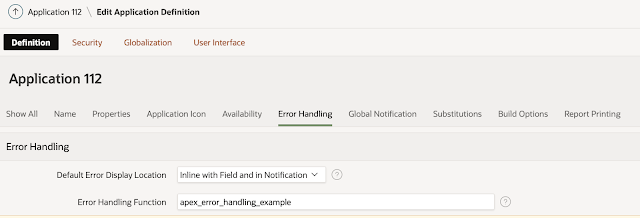If you run your APEX application - like a Form based on the EMP table - and test if you can change the value of Department to something else then the standard values of 10, 20, 30 or 40, you'll get a nice error message like this:
But it isn't really nice, is it? So what do a lot of developers do? They create a validation (just) in order to show a nicer, better worded, error message like "This is not a valid department". And what you then just did is writing code twice : Once in the database as a (foreign key) check constraint and once as a sql statement in your validation. And we all know : writing code twice is usually not a good idea - and executing the same query twice is not enhancing your performance!
So how can we transform that ugly error message into something nice? By combining two APEX features: the Error Handling Function and the Text Messages!
Start with copying the example of an Error Handling Function from the APEX documentation. Create this function in your database schema and define this as the Error Handling Function for your application:
When you put this in place, the message gets a bit better - the ORA-02291 is removed - but still not that you would like to show to your customer.
Now lets add a few lines to that Error Handling Function in the part that handles the contraint violations. The original code is this:
if p_error.ora_sqlcode in (-1, -2091, -2290, -2291, -2292) then
l_constraint_name := apex_error.extract_constraint_name (
p_error => p_error );
begin
select message
into l_result.message
from constraint_lookup
where constraint_name = l_constraint_name;
exception when no_data_found
then null; -- not every constraint has to be in our lookup table
end;
end if;
Now change the select from the constraint_lookup table (which we don't have anyway) into:
if p_error.ora_sqlcode in (-1, -2091, -2290, -2291, -2292) then
l_constraint_name := apex_error.extract_constraint_name (
p_error => p_error );
l_result.message := apex_lang.message( l_constraint_name );
if l_result.message = l_constraint_name then
apex_lang.create_message( p_application_id => v('APP_ID')
, p_name => l_constraint_name
, p_language => apex_util.get_preference
('FSP_LANGUAGE_PREFERENCE')
, p_message_text => 'TODO'
);
commit;
end if;
end if;
So the first step is to "translate" the message using the constraint name ( e.g. EMP_DEPT_FK) as a parameter. If that value is not found the apex_lang.message will simply return the parameter value. So if that happens, the procedure apex_lang.create_message is called to create a Text Message entry with a default text "TODO'.
When we run our test case again, the first time we get an error that is only showing the constraint name as a message.
If we immediately press the Save button again, we get a different message.
Now head over to the APEX Designer, Shared Components, Text Messages and look for the messages you still need to change:
And after adding a meaningful message, run your test again.
So without writing any additional validation code on your pages, you can show a nice, user-friendly error message by just using the power of APEX and the Oracle Database.
Of course this is just a simple example of what you can do with an Error Handling Function: just to name an example or two, you can also send an email from that function or do a REST call from one database to another.







Comments